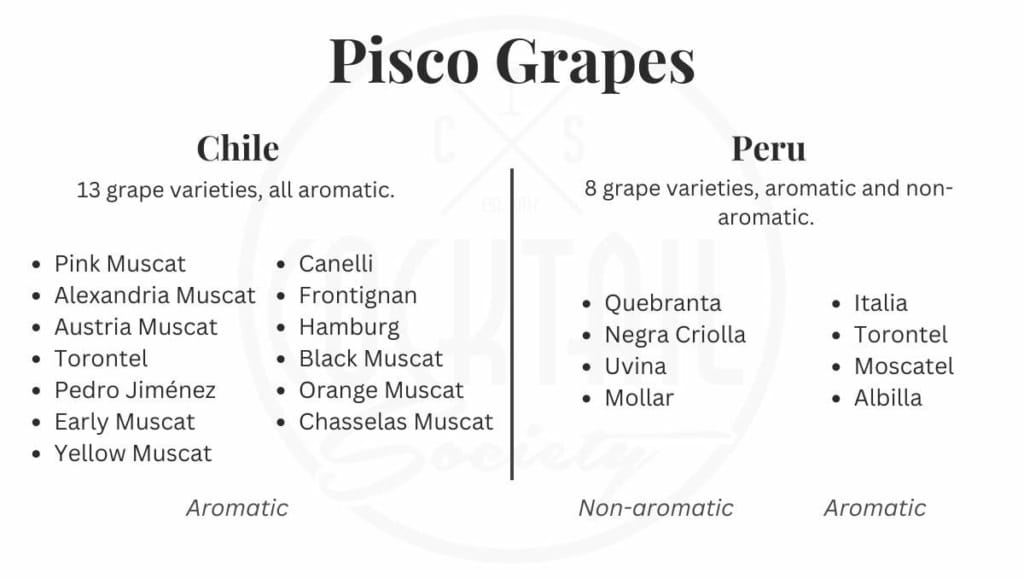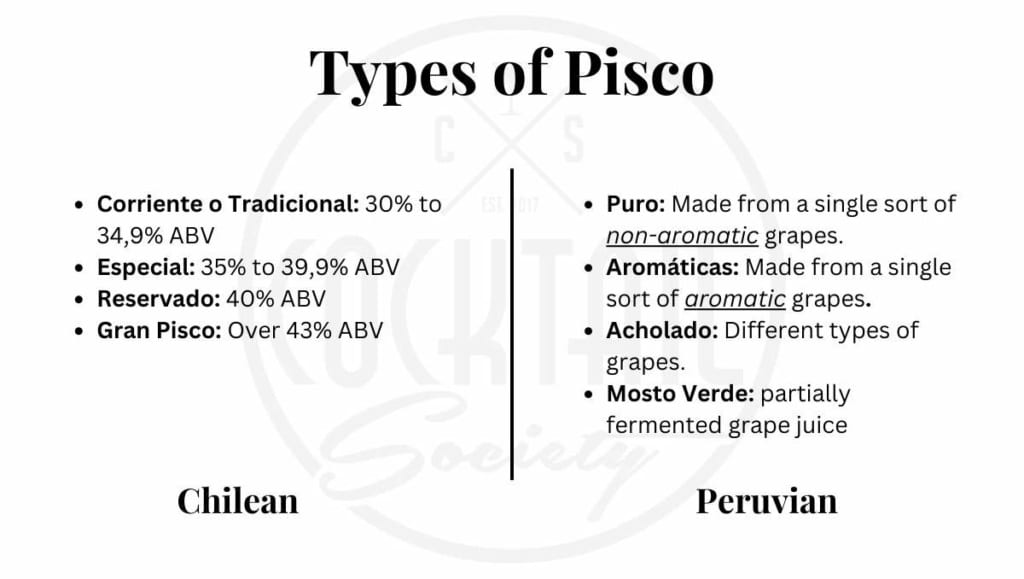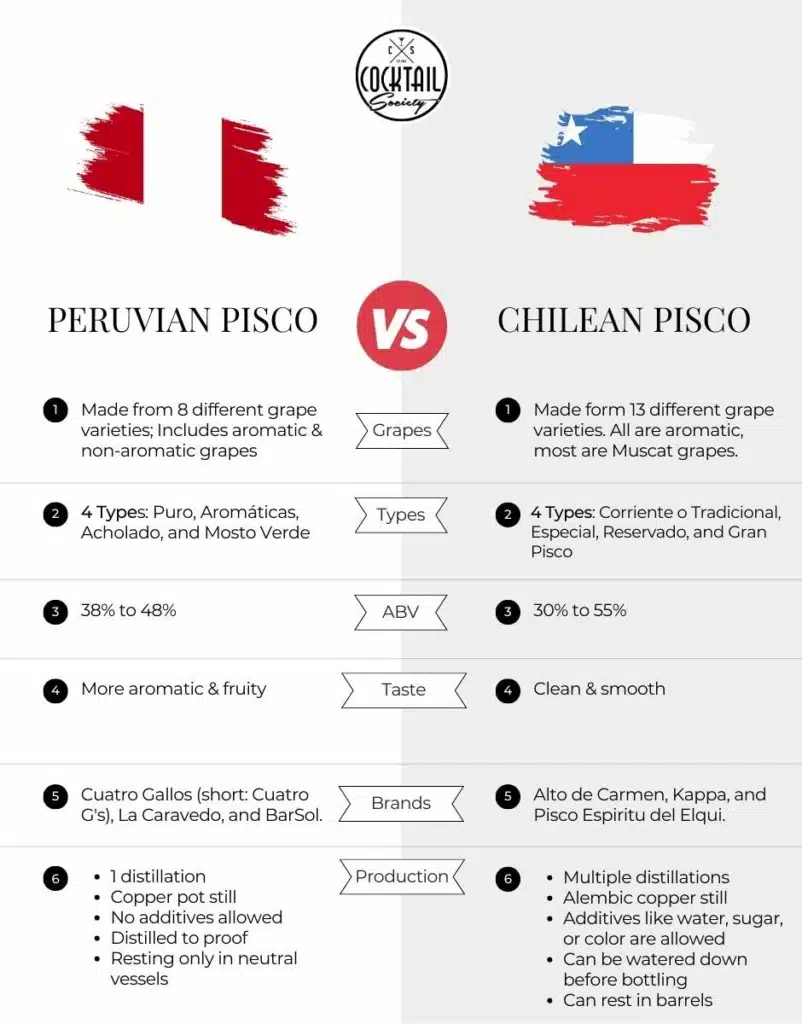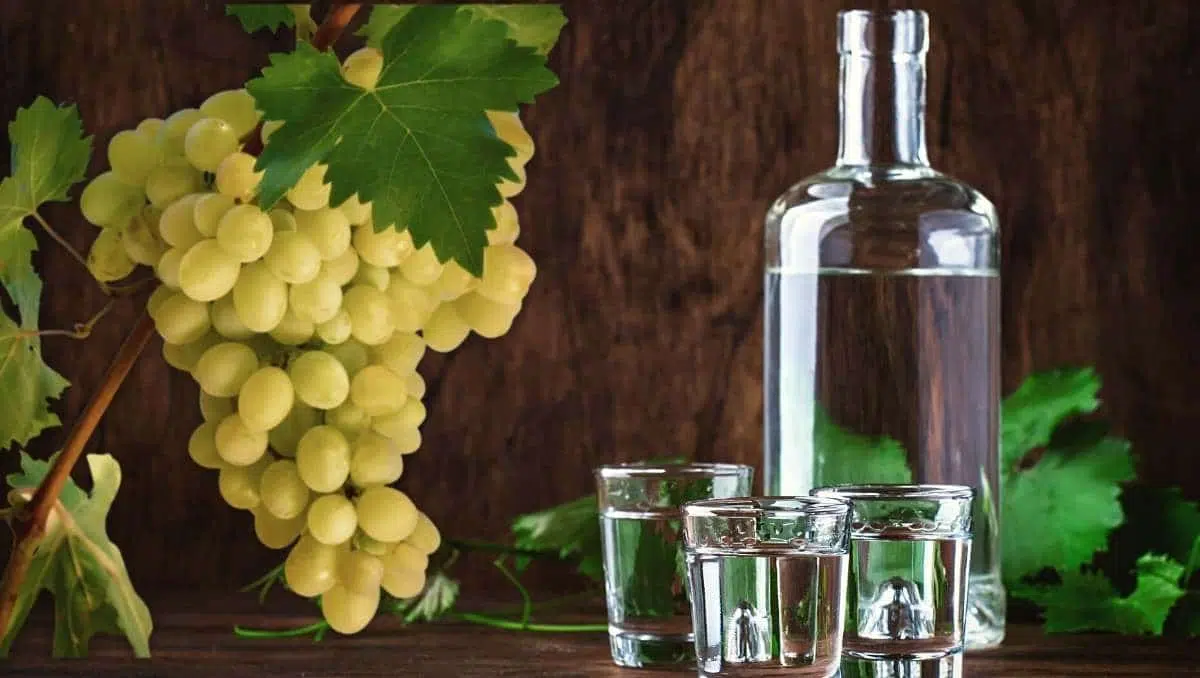Pisco is one of South America's favorite spirits, especially in cocktails and mixology. It's a type of brandy distilled from grape wine or fermented grape juice that can be either clear-colored or have an amber shade. It has an alcohol content of 38% to 48% (Peruvian Pisco) or 30% to 55% (Chilean Pisco).
The aroma of pisco resembles wine, and the taste is heavy on grapes with only a little alcoholic bite and hints of green apple. Like with brandy, the aroma is more intense than the actual taste.
One of the most popular drinks made with pisco, and the national cocktail of Peru and Chile, is the Pisco Sour. Why Peru and Chile? Because there's an ongoing dispute about who invented the high-proof spirit. It is unlikely that the question of origin will get answered satisfactorily in the foreseeable future. Nevertheless, there are a lot of facts worth knowing about pisco.
What is Pisco Made Of?
Pisco is always made from fermented grape juice. However, Peruvian and Chilean Pisco have different regulations and are produced in slightly different ways. The basic production steps include juicing and fermenting grapes, then distilling the fermented juice into a high-proof spirit.

The grapes used to make Peruvian Pisco must be one of 8 grape varieties. These are Quebranta, Negra Criolla, Uvina, Mollar, Italia, Torontel, Moscatel, and Albilla. -The first four are non-aromatic, and the other ones are aromatic.
Chilean Pisco, on the other hand, allows 13 different grape varieties. These are Pink Muscat, Alexandria Muscat, Austria Muscat, Torontel, Pedro Jiménez, Early Muscat, Yellow Muscat, Canelli, Frontignan, Hamburg, Black Muscat, Orange Muscat, and Chasselas Muscat.
How Does Pisco Taste?
The taste of pisco varies depending on its origin and brand. Like brandy, it has a more intense aroma than flavor, with perfumy grape notes resembling wine. Pisco tastes relatively fruity, a little sweet, and you can definitely taste the grapes. Quality products are very smooth, and only cheaper options will have a significant burn from the alcohol.
Many compare it to grappa (especially the Peruvian type), an unaged grape spirit from Italy. Both are based on grapes and have a fruity aroma. Yet, grappa has a much stronger alcoholic bite.
Since Peruvian Pisco rests and matures in neutral vessels - glass or steel instead of wood- the aroma of the grape variety used always shines through. These grapes can be tart and more citrusy or fruity, with, for instance, apple and peach notes. Some taste almost nutty, and others are sweet and fragrant like vanilla.
Pisco vs. Grappa vs. Brandy
Pisco and grappa are both sup-types of brandy distilled from grapes. The main difference is that pisco is made from fermented grape juice (like brandy) and grappa from grape pomace, leftovers from wine production like grape skin, seeds, and stalks. They also have different origins, with pisco coming from Peru & Chile, grappa from Italy, and brandy from France.
You can only make grappa and pisco from grapes, whereas brandy you can also produce from other fruits like apples, apricots, or peaches. Here's an overview of how the three spirits compare.
| Pisco | Grappa | Brandy | |
|---|---|---|---|
| Made from | Fermented grape juice | Grape pomace | Fermented fruit juice (like grapes, apples, peaches, etc.) |
| Origin | Peru / Chile | Italy | France |
| Taste | Smooth and grape-forward | Distinct alcohol burn, notes of plum and grapes | Smooth and fruity (depending on base ingredient) |
| Aging / Resting | Minimum of 3 months | No minimum | Minimum of 2 years |
| Base ingredients | Specific grape type | Any grapes | Different kinds of fruits |
| Distillation | Distilled to proof or Watered down after distillation | Watered down after distillation | Watered down after distillation |
| Flavoring | Partly allowed | Allowed | Not Allowed |
Where is Pisco From?
Presumingly, Peru was the first country to produce pisco. Still, there is an ongoing dispute between Chile and Peru, regarding the origin of a grape spirit with the name pisco.
As you can see from the respective regulations below, Peruvian Pisco, and Chilean Pisco are similar but not the same thing. So the main controversy is actually about the name.
Both countries have pisco as their national drink, rely on the spirit economically, and both may have a right to call it their own.
Yet, the first official record of pisco as a grape spirit is from Peru, and so is, most likely, the name. Spanish export documents from the City of Pisco in South Peru from 1764 mention a spirit with that name -Possibly a reference to the Quechuan word for bird Pisqu, by the way.
Naturally, that doesn't mean Chile didn't start producing a similar alcoholic beverage from grapes around the same time. After all, the Spanish brought their grapevines two both countries around the same time as well.
The Chileans are said to have copied the name when they couldn't come up with an idea of their own. But then again, no evidence proves Peru was the first country that produced what later became pisco. Then again, neither do we have conclusive proof that Chile didn't use the name pisco before the Peruvians did.
Interesting side note: in 1936, Chile even named a village in the Elqui valley Pisco Elqui to support their claims. I don't think that helped their cause a lot, though.
How to drink it
You can drink pisco neat, on the rocks, in a mixed drink, before a meal, or after. When you opt for neat, sip it slowly and not in one go. Mosto Verde, a unique style made from partially fermented "green" grapes, is typically served as an aperitif before a meal.
However, our preferred way to drink pisco is in a Pisco Sour cocktail. The national drink of Chile and Peru consists of pisco, key lime juice, and egg whites. Before serving, garnish the cocktail with a few drops (usually three) of Angostura bitters.
In Peru, there's another popular way: They infuse their pisco with fruits and herbs and call the results macerados. Many bars and restaurants offer these drinks in all sorts and flavors. These macerados are commonly used in cocktails, as they would be too aromatic to consume neat. Typical flavors are strawberry, coconut, pineapple or coca leaves, ginger, and chili.
Types of Pisco
Pisco is categorized into Peruvian and Chilean Pisco. In total, there are eight different types, four from each country.

Chilean Pisco Types
The four main types of Chilean Pisco are defined solely by the alcohol content:
- Pisco Corriente o Tradicional with 30% to 34,9% vol. (60 to 70 proof)
- Pisco Especial with 35% to 39,9% vol. (70 to 80 proof)
- Pisco Reservado with 40% vol. (80 proof)
- Gran Pisco with 43% vol. or more (86 or more proof)
Peruvian Pisco Types
- Puro (Pure): that type can only be made from one single grape variety. The blending of different types of grapes is not possible within this category. Plus, the grapes for Puro must be non-aromatic. -Mostly, they are of the Quebranta variety.
- Aromáticas (Aromatic): like Puro, Pisco Aromáticas must be made with just one sort of grape. But for this category, it's aromatic grapes only. Typically that would be grapes of the Muscat family, or also Italia, and others. Those are also the grapes typical for Chilean Pisco.
- Acholado (Multivarietal): For Pisco Acholado, producers can use different types of grapes. It is the least stringent category.
- Mosto Verde (Green Must): for making Mosto Verde, the grape must get distilled before the fermentation process is completed. So, not all sugar has transformed into alcohol at the time of distillation.
Chilean Pisco vs. Peruvian Pisco
The key difference between Peruvian and Chilean Pisco is that the first tends to be more aromatic. Peruvian Peru is also subject to stricter specifications regarding the selection of grapes and the distillation process.
In a nutshell, here are the most relevant aspects that tell them apart.

Grapes
Peru defined eight varieties allowed for pisco production, including aromatic and non-aromatic types. Chilean producers can use 13, but they're all aromatic, and most belong to the Muscat grape family. Some grape varieties are employed in the Chilean and Peruvian versions, but Peru cultivates them in a more humid climate, while Chile's farmers grow them under desert conditions.
In Chile, pisco producers have to use their own grapes, which Peruvian law does not require. To see a complete list of the grapes used, refer to our list above.
Types
Both countries categorize their pisco into four categories. In Peru these are Puro, Aromáticas, Acholado, and Mosto Verde. In Chile, the four categories are defined solely by alcohol content. The Chilean Pisco types are Corriente o Tradicional, Especial, Reservado, and Gran Pisco.
For more detailed information, check out our guide to the types of pisco above.
ABV
The alcohol content of Peruvian Pisco is between 38% and 48%, and pisco from Chile clocks in between 30% and 55%.
Peruvian Pisco is only distilled once and bottled straight at distillation strength. -Adding water is prohibited. The alcohol level has to be between 38 and 48% vol.
However, Chile's producers can distill their products as often as they like, which leads to higher alcohol content. On the other hand, they can dilute their product to lower ABV. That leads to a larger spectrum regarding ABV.
Taste
Generally, you can say that pisco from Peru is more aromatic and fruity than the products from Chile. However, unlike Peru, Chile allows additives that can alter the taste of the spirit.
Pisco from Chile is smoother and cleanser due to multiple distillations. These remove impurities from the spirit, but also flavor.
Popular brands
Both countries have a large variety of brands and products of excellent quality. Popular Peruvian Pisco brands are Cuatro Gallos (short: Cuatro G's), La Caravedo, and BarSol. For Chilean pisco brands, look out for Alto de Carmen, Kappa, and Pisco Espiritu del Elqui.
Production
Peruvian Pisco must be distilled in copper pot stills. After distillation, it can rest only in neutral vessels, including materials like copper, glass, or steel. No additives are allowed, and the spirit needs to be bottled at distillation strength.
Pisco from Chile often rests in wooden barrels. Plus, additives like water, sugar, or coloring are allowed. Also, a column style still cannot be used, nor is continuous distillation allowed. It can be discontinuous only. They use copper stills similar to the alembics for Cognac production.
Origin of Pisco
Spanish seafarers brought grapevines to South America in the mid-16th century. Only a few years later, by 1560, Peru was producing wine commercially.
The wine industry in the region quickly grew bigger and bigger, and it wasn't too long before the Spanish Crown became concerned about it. After all, they wanted to sell and export their wine to the Americas.
Consequently, the Spanish prohibited establishing new vineyards from 1595 onwards. With a safe distance of over 5000 miles between Peru and Spain, most of which is an ocean, one can safely assume that this ban wasn't taken too seriously. The wine was, therefore, plentiful in the country.
The problems arose when the Spanish started prohibiting and controlling the export of Peruvian wine. Now there was an immense surplus of grapes and wine, which probably was why people started making local Brandy from the fruits.
Around the same time, the Peruvian coastal town of Santa Maria Magdalena established its "Port of Pisco" as the distribution hub for Aguardiente.
Aguardiente is the generic term for traditional Latin American high-proof alcoholic beverages. And from the early 17th century onwards, it often had a grape base, presumably due to the previously explained surplus.
Across the decades, sailors entering the Port of Pisco caused a growing demand for the grape spirit. They also distributed it along the coastline and beyond. And adopting the name of the port, the town of Santa Maria Magdalena and the grape spirit were soon known as pisco.
Despite everything, Peruvians continued to use their grapes primarily for making wine. It took more than a century for production to catch up. However, by the 1760s, pisco accounted for over 90% of the produced grape beverages, leaving wine far behind.
The Denomination of Origin of Chilean Pisco
Chilean Pisco is primarily produced from the Muscat grape family, with some vineyards also cultivating other varieties. In 1931, the Chilean government issued a denomination of origin (D.O.) for pisco.
Since then, it can only be produced in the valleys of Copiapó, Huasco, Elqui, Limarí, and, later, Choapa. -That, by the way, was the first D.O. ever issued in the Americas.
Along with the Denomination of Origin, the government also decided on an official classification for pisco. Unlike the different types of Tequila or Mezcal, this classification has nothing to do with aging. It's also not about the sugar content, as it is for Prosecco. The four main types of Chilean Pisco are defined solely by the alcohol content.
For all these types, Chile has defined some additional regulations. All distillers have to cultivate their grapes for their spirit. The majority of these grapes need to be from certain varieties defined by the government.
Plus, producers have to use traditional production methods. Otherwise, they cannot label their spirit pisco.
The Denomination of Origin of Peruvian Pisco
Sixty years after Chile issued the first D.O. for its pisco, Peru followed. Since 1991, their law requires pisco to originate from one of five D.O. departments. These departments are Lima, Arequipa, Ica, Tacna, and Moquegua.
However, in contrast to products from Chile, Peruvian Pisco can be made from various grapes - aromatic and non-aromatic. That leads to a wide variety of flavors and different viscosities and appearances of the spirit.
This circumstance, in turn, meant it was difficult for Peru to export their products under a single denomination. Therefore, they decided on four general categories of their pisco. For each of these categories, the government had defined different rules and regulations that the products must meet.
On top of the regulations for each category, Peruvian Pisco must age for a minimum of three months in inorganic vessels. That would be glass, steel, and the like. It cannot be anything that would alter the taste of the spirit. Consequently, wood barrels are not an option.
Second, no additives that can alter the flavor, appearance, aroma, or alcohol content are allowed.
The second point is cause for another noteworthy difference from the Chilean version: Peruvian Pisco never gets diluted with water. It's bottled straight at its distillation strength.
Global Pisco Market
At this moment, Peru is exporting much more Pisco than Chile. In the distant past, this was a different story. But already in 2014, Peru exported two to three times the amount Chile exported, and the number only grows, as Peruvian brands diligently promoted their products in recent years.
In 2022 alone, the Peruvian Pisco export grew by 45% to slightly more than $10 million. However, people in Chile are consuming way more than their Peruvian neighbors. In 2016, the average pisco consumption per person was 2 liters in Chile, whereas, in Peru, it was only 0,22 liters.
Yet, looking back another 15 to 20 years, the situation was quite different. Chile had an export volume for pisco that outranked the Peruvians by far. According to eater.com, around the Millenium, Chile used to export approximately 20 times more than Peru.
You're wondering what happened? Peruvian government and producers invested a lot of work and time into their pisco business, it appears that paid off.
Cocktails with Pisco
The best-known and most popular cocktail containing pisco is the Pisco Sour. You can get it everywhere when in Peru or Chile, in bars, restaurants, and even cafés. It's a classic Sour Cocktail that follows the template of base spirit, lime juice, and simple syrup, plus egg white and a dash of bitters.
- Chilcano de Pisco is another traditional and popular drink. It's a composition of pisco, ginger ale, lime juice, and Angostura bitters.
- Pisco Punch is a combination of simple syrup, lemon, pineapple juice, and pisco. A recipe from the US-West Coast that came up during the Gold Rush in the late 1800s and early 1900s.
- The Judgement Day cocktail combines pisco with elderflower liqueur - St. Germain is the leading brand here. The remaining components of this drink are lime and lemon juice, syrup, egg white, and Pimento Dram bitters.
For more ideas and recipes, check out this list of the best pisco cocktails.
Pisco FAQs
Can you drink pisco straight?
Yes, pisco is often served straight in Chile and Peru as it's so smooth. You slowly sip the spirit to enjoy its delicate taste and aroma.

